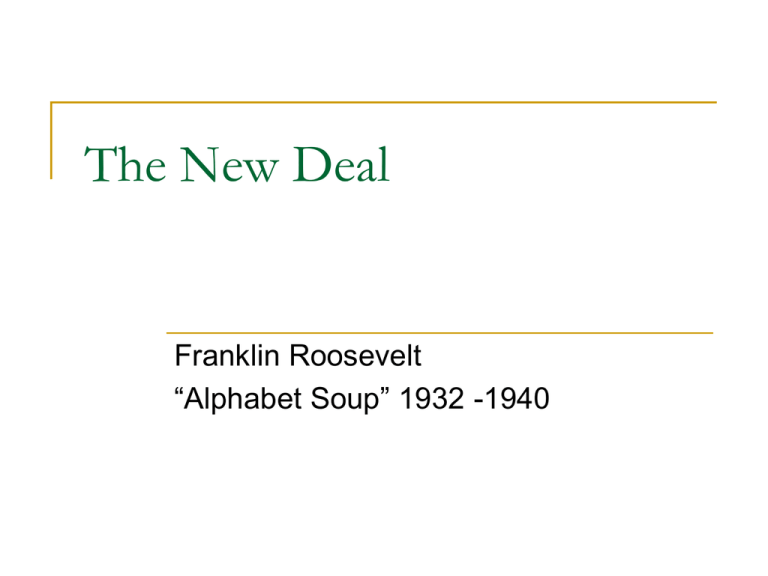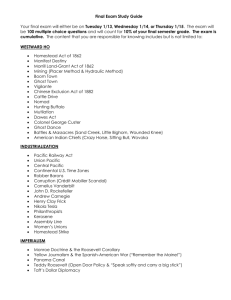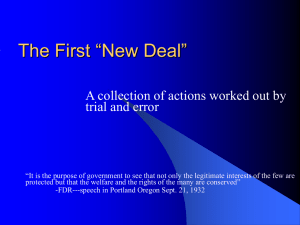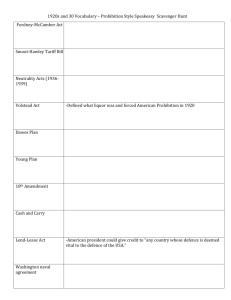The New Deal - History Home Page
advertisement

The New Deal Franklin Roosevelt “Alphabet Soup” 1932 -1940 The New Deal Begins Inauguration - FDR was sworn in as 32d US President, March 1933. With no blueprint of what to do concerning the growing economic crisis, he did not know for certain what would or would not work. He had tried many innovative things while Governor of NY. He manifested a flexible, pragmatic approach to meet the economic crisis, and brought with him his NY "Braintrust” After many serious runs on banks, FDR declared a 4-day banking holiday 59 March From 1930 to FDR's inauguration, 5,504 banks closed with deposits totaling almost $3.5 billion. Hundred Days – March - June 1933 With strong majorities in both Houses of Congress, a special session of the 73d Congress began in March, at first focusing on immediate relief. What emerged was a 3-fold focus – Relief - Recovery – Reform First action of the special session -Emergency Banking Relief Act The President was given broad powers over credit transactions and over transactions in currency, gold, silver and foreign currency. Gold hoarding and exportation of gold was prohibited (10-year sentence + $10,000 fine) as the US was taken off the gold standard for its currency. Banks could reopen if they could prove solvency (They had enough money). Relief Actions Federal Emergency Relief Act - May 1933 It established the Federal Emergency Relief Administration (FERA ) and appropriated $500 million for quick relief with 1/2 given immediately as direct relief It matched $1 for every $3 the states added to their own relief programs. Relief Actions Reforestation Relief Act - March 1933 It created the Civilian Conservation Corps (CCC) with 250,000 immediate jobs for men aged 18-25 at $30 per month with as much as $25 being sent home Members were supplied with food, shelter, transportation, clothing, medical care and some education or training. Projects included reforestation, road construction, soil erosion and flood control, and development of national parks, although critics claimed this was "make work." By its end in 1941, 2 1/2 million men had worked in 1,500 CCC camps. Recovery Actions Agricultural Adjustment Act (AAA ) 12 May 1933 It was designed to restore purchasing power of agricultural producers by cutting production eliminating surplus crops of basic commodities and establishing parity prices (a) It established the subsidy principle whereby, for voluntary reduction of acreage in production, farmers were paid direct benefits or rental payments. (b) It authorized the president to inflate the currency by devaluating its gold content or the free coinage of silver and issue $3 billion in paper currency. (c) It also provided funds for loans to farmers to meet their mortgage payments. Farm Credit Act - 16 June 1933 (d) Payments for these programs would come from a production tax on the processors of certain farm commodities. (e) The processors tax (and the AAA itself funded by the tax) was struck down by the US Supreme Court - US v Butler (Declared unconstitutional) Recovery Actions National Industrial Recovery Act (NIRA ) June 1933 The NIRA was designed to balance the interests of business and labor and consumers and to reduce unemployment. For codes of fair competition, anti-trust laws were suspended. Section 7(a) guaranteed workers the right to collective bargaining. It established minimum wage and maximum hour laws. Supreme Court struck down parts - Schechter Poultry v US 1935 (Declared unconstitutional) Reform Actions Tennessee Valley Authority (TVA) May 1933 Under FDR, Tennessee Valley Authority was created and all government-owned property at Muscle Shoals was transferred to the Authority, governed by a three-man board. The Authority was charged with building dams, generating and selling electricity, manufacturing and selling fertilizers produced, establishing flood control and developing navigation. Six dams were completed before World War II. Critics charged that it was unfair competition with private companies supplying electricity in the area. (TN, NC, KY, VA, MS, GA) It was the only such project developed domestically. Reform Actions Federal Securities Act - May 1933 It required the Federal Government to register and approve all issues of stocks and bonds and issuers to make full disclosure all pertinent information about an issuing company. On 6 June 1936, some of its duties were assumed by the Securities Exchange Act which created the Securities and Exchange Commission (SEC) Joseph P. Kennedy was the first chairman of the SEC. Reform Actions Banking (Glass-Steagall) Act of 1933 - June 1933 It created the Federal Deposit Insurance Corporation (FDIC ) empowered to guarantee individual bank deposits up to $5000. It permitted branch banking, allowed savings and industrial banks to be members of the Federal Reserve System and separated commercial banking from investment banking thus eliminating excessive speculation with depositor's funds. Repealed in 1999. Many believe it led to the crisis of 2007-08 Those Who Thought That the New Deal Had Not Gone Far Enough Dr. Francis Townsend -- Old Age Revolving Pension Plan Rev. Charles E. Coughlin and the National Union for Social Justice Senator Huey P. Long (1893-1935) and the Share Our Wealth Movement Dr. Francis Townsend He called for payments of $200 per month to persons over 60 years of age, to be paid for by a 2% tax on all commercial transactions. Each recipient would have to spend it all within the month. By 1935, they claimed 5 million backers, illustrating a desire for a kind of old age pension. Rev. Charles E. Coughlin The Jesuit priest, Charles Coughlin, lived in Royal Oak MI and in 1930, began a radio broadcast in Detroit, which eventually claimed almost 40 million listeners At first an enthusiastic supporter of the New Deal, but by 1934, he voiced the opinion that FDR was not going far enough. He was specific in calling for silver inflation, but was extremely vague on other issues, offering no real solutions. His broadcasts attacked international bankers, Communists, labor unions, and Roosevelt's administration, as unemployment remained high. Huey Long Demanded that the government make Every man a King Guarantee every family an annual income of $2,000 and a homestead or $6000 to build a home To pay for this, the government would nationalize all banks and allow no one to be over a "ten millionaire." Clubs sprang up across the country, especially in the South, supporting the Share Our Wealth concept. Huey Long 8 September - Long was shot at the Capital building in Baton Rouge, dying of internal bleeding on 10 September 1935. His alleged assailant, Dr. Carl Austin Weiss Jr. whose father-in-law had been ruined by Long, was immediately killed by Long's bodyguards. Phase II of the New Deal - 1935-36 By Executive Order, he created additional relief agencies in 1935: Works Progress Administration (WPA ) Harry Hopkins put in charge. The WPA spent $11 billion, and employed over 81/2 million in over 1,410,000 projects between 1935 and its termination June 1943. Projects involved manual labor to build public buildings, schools, airfields, parks and post offices, but many projects involved writers, artists, scholars, musicians and actors. Phase II of the New Deal - 1935-36 Federal Art Project Employed 5,000 in 44 states. While most critics charged that the WPA was inefficient, wasteful and politically corrupt, it did increase the national purchasing power. Rural Electrification Administration (REA ) Its goals were to provide electricity to isolated rural areas, where it was not feasible to provide service by private utility companies. The REA made low interest, long-term loans for the entire cost of constructing light plants and power lines into such isolated areas. Additional Reform Efforts 1935 National Labor Relations (Wagner-Connery ) Act: Established the National Labor Relations Board (NLRB) Section 7 guaranteed employees could join labor unions and bargain collectively through labor representatives. Section 8 defined unfair practices on the part of the employer. Most importantly, it compelled employers to recognize a union if over 50% of the employees joined the union. Additional Reform Efforts 1935 Social Security Act - August 1935 Partially as the result of the Townsend-Long proposals, the act established a cooperative federal-state system of unemployment compensation by levying a federal tax on total payrolls of those employing eight or more persons (1% in 1936, 2% in 1937, 3% thereafter) It levied a tax (1% in 1937) equally between employee and employer to provide for old-age pensions for retirees in January 1942, receiving monthly checks between $10-85. For persons already retired, the federal government shared the costs with states ($15 per month matching funds plus some aid for administrative costs). Grants were provided for financial aid for the blind, homeless, crippled and dependent children, and some services such as maternity and infant care Court Packing During Roosevelt's first term, the Supreme Court struck down as unconstitutional major pieces of New Deal Legislation. Feb 1937 - Roosevelt, determined to halt this continued threat to his New Deal, introduced the Judiciary Reorganization Bill Court Packing Judiciary Reorganization Bill proposed to add judges at all levels of the federal courts, assign judges to the more congested courts and adopt procedures to expedite the appeals process by sending lower court cases on constitutional matters directly to the Supreme Court Its main purpose, however, was to add justices to the Supreme Court Justices of the Supreme Court who reached age 70 could retire. When a Supreme Court justice, age 70, did not retire, FDR could add an additional judge up to 6, potentially increasing the court to 15 members. Court Packing A serious debate erupted: Roosevelt was accused of attempting to upset the balance of powers which existed in the US system, by "packing" the court. Many desired such changes to be put into a constitutional amendment The bill reached a serious impasse in Congress in 2 months, dividing Democrats As the opposition mounted a serious attack against the bill, Roosevelt countered that six old men should not erode the people's wishes and that he was instead trying to restore the balance of power between the three branches of government. Phase III of the New Deal 1938 Second Agricultural Adjustment Act a. Reestablished the "parity payment" principle. b. Established the Federal Crop Insurance Corporation (FCIC) within the Department of Agriculture to insure wheat crops only beginning in 1939. c. The financing would be provided by the Federal Government, not a processor's tax. Phase III of the New Deal 1938 Fair Labor Standards (Wages and Hour ) Act June Businesses engaged in interstate commerce (with some exceptions) were required to pay a minimum wage of 40 cents per hour (up from 25 cents). In 1967, farm workers were included at $1.00 per hour. The work week was limited to 44 hours per week without overtime, beginning in 1938 and later trimmed to 40 hours per week by October 1940. Children under 16 were not allowed to work; where hazardous, the age limit was 18. The end... Next up: World War II…



